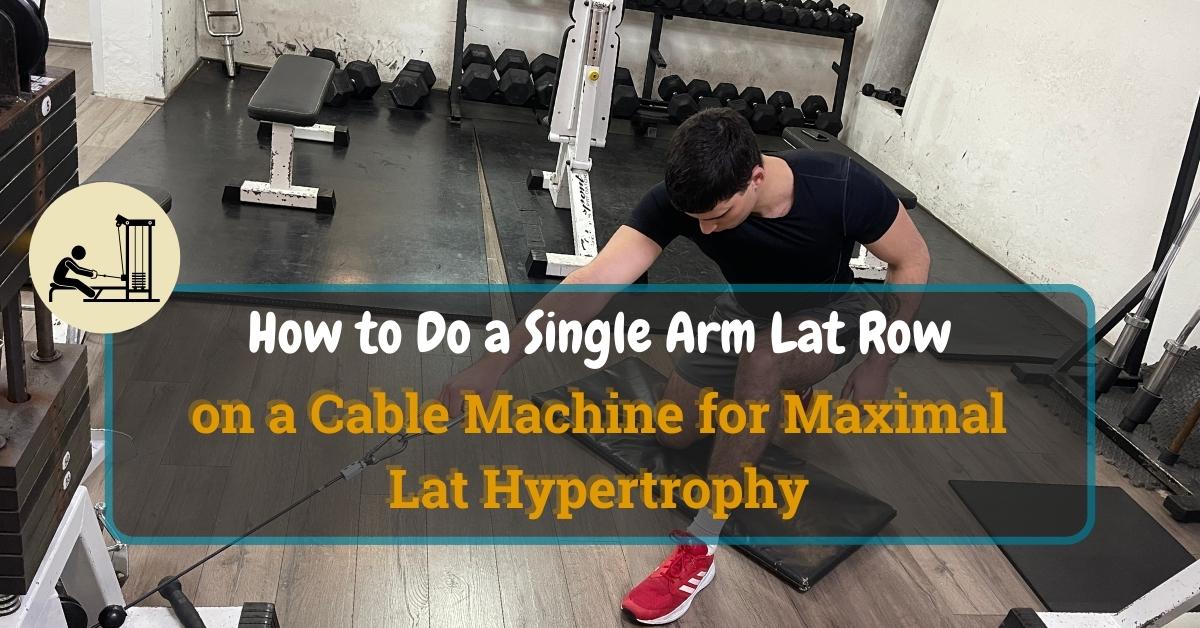There is a specific way to perform a single arm lat row on a cable machine and just about any other piece of equipment to target and grow your lats better.
Table of Contents
ToggleI regularly implement this single-arm lat row variation during my pull workouts, and I can tell you the results are amazing.
Let’s get started with a step-by-step guide on how to perform this unilateral arm lat row variation with a cable attachment for maximal lat hypertrophy.
Start Building Your Dream Body Today
Ready to elevate your fitness game without falling into the trap of dull, repetitive routines that just don’t deliver? Imagine sculpting your ideal physique and boosting your health, all while still enjoying life’s pleasures, like those irresistible weekend getaways and your aunt’s legendary cheesecake. With our online fitness and nutrition coaching service, you don’t have to compromise. Dive into a personalized fitness journey that blends perfectly with your lifestyle, not against it. Book your completely free discovery consultation today, and take the first step towards a transformation that doesn’t require giving up the joys of life.

“I was skeptical about online fitness coaching, but Functional Body Savage completely changed my perspective. Vanja and Radomir’s personalized approach and attention to detail have helped me achieve goals I never thought possible. I’m stronger, more confident, and grateful for their guidance.”
Emily Thompson, San Francisco, CA
Learn More About Our Online Coaching ServiceQuick Summary
- To perform a single arm lat row on a cable machine for maximal lat hypertrophy, begin in a half-kneeling position, pull the cable towards your hip with the elbow close to the body, and focus on engaging and squeezing the lat muscles.
- The exercise includes pulling the cable towards the hip with a focus on lat engagement and controlling the movement during both the pulling and returning phases.
- According to a study by Fenwick, Brown, and McGill, the standing bent-over row activates muscles from the upper to lower back, and one-armed cable rows are beneficial for torsional endurance or strength.
- Based on my extensive experience in the field, I can confidently say that combining dumbbell and cable rows in a workout routine enhances lat development, offering a comprehensive approach to building back muscle strength and definition.
How to Do a Single Arm Lat Row on a Cable Machine
Here is how to perform a single arm lat row on a cable machine for outstanding muscle hypertrophy of a latissimus dorsi.
Step One – Assume the Half-Kneeling Starting Position
Begin by adjusting the cable machine with a single handle attachment at the lowest setting.
Choose a weight that allows you to perform the exercise with proper form. Stand in front of the cable machine and drop into a half-kneeling position. Ensure your body is stable and upright, with your hips facing forward.
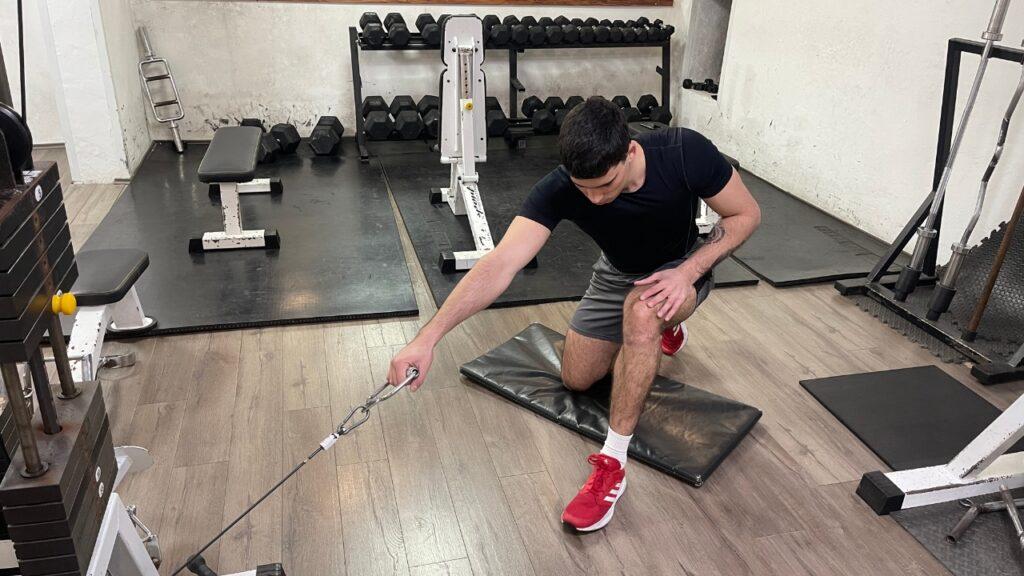
Pro Tip: In my years of training clients, I’ve noticed that stability is key in the half-kneeling position. I recommend engaging your core and glutes to create a solid base. This position also helps in preventing lower back strain, a common issue I’ve seen in beginners and even seasoned athletes.
Step Two – Pull the Cable Towards Your Hips
Grasp the handle with the hand closest to the machine, ensuring your palm faces inwards. Keep your arm extended and your shoulder relaxed. Engage your core and lats as you pull the handle towards your hip.
Keep your elbow close to your body and focus on using your back muscles, not just your arm. Once the handle is close to your hip, squeeze your lat muscles to maximize the contraction. Hold this position briefly to enhance muscle engagement.

Pro Tip: One common mistake I’ve corrected in numerous clients is over-relying on arm strength. Focus on initiating the pull from your lats. I often cue clients to imagine ‘pulling’ from their armpit area. This mental trick greatly improves muscle engagement and effectiveness.
Step Three – Return the Cable to the Starting Position
Slowly extend your arm back to the starting position. It’s crucial to maintain control during this phase to ensure constant tension on the lats. Also, I want you to extend your arm as far as you can to stretch the lats to their maximum length.
Perform the desired number of repetitions, focusing on form and muscle engagement. After completing one side, switch to the other to maintain balance in muscle development.
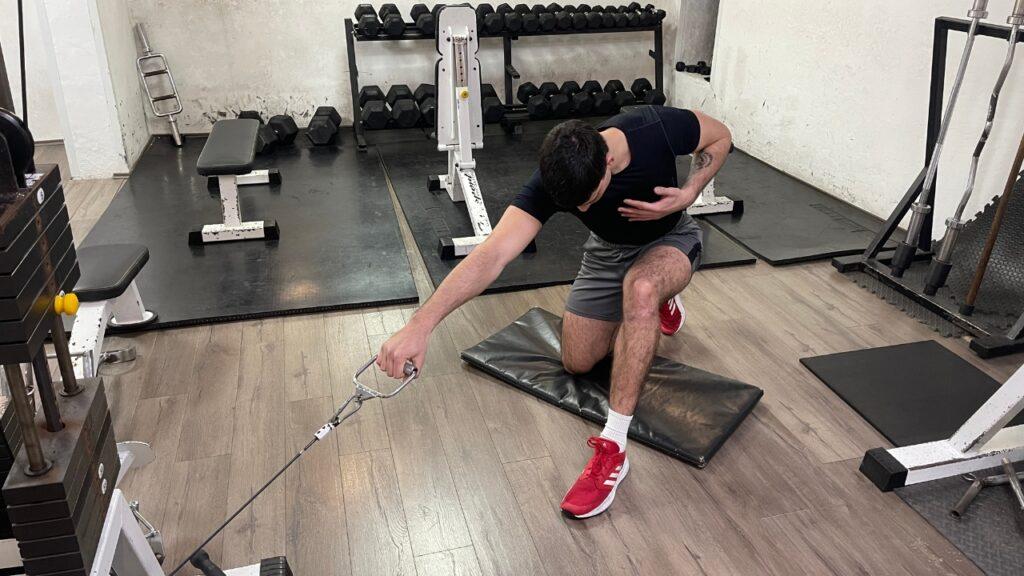
Pro Tip: The eccentric (return) phase is just as important as the pull. I always advise clients to take it slow on the way back. This increased time under tension does wonders for muscle growth. In my experience, clients who master this technique see noticeable improvements in muscle definition and endurance.
How Do You Do a Single Arm Cable Row Without a Machine?
Not everyone has access to a cable machine, but that doesn’t mean you can’t effectively work your lats. Here are some excellent alternatives to using different equipment.
Single Arm Lat Row Dumbbell Alternative
Dumbbell rows are a staple in back workouts and are highly effective due to their simplicity and the stability challenge they offer.

Steps:
- Start by standing beside a bench.
- Place one knee and the same side hand on the bench for support, keeping your back flat.
- With your free hand, lift a dumbbell from the floor, keeping your arm extended.
- Pull the dumbbell towards your hip, focusing on the lat contraction.
Pro Tip: During my personal training sessions, I emphasize the importance of elbow positioning. Keeping the elbow close to your body targets the lats more effectively. Clients often find that visualizing driving the elbow towards the ceiling helps maintain proper form.
Single Arm Lat Row Kettlebell Alternative
Kettlebell rows will improve your grip strength and offer slightly different muscle engagement patterns due to the unique shape and weight distribution of kettlebells.
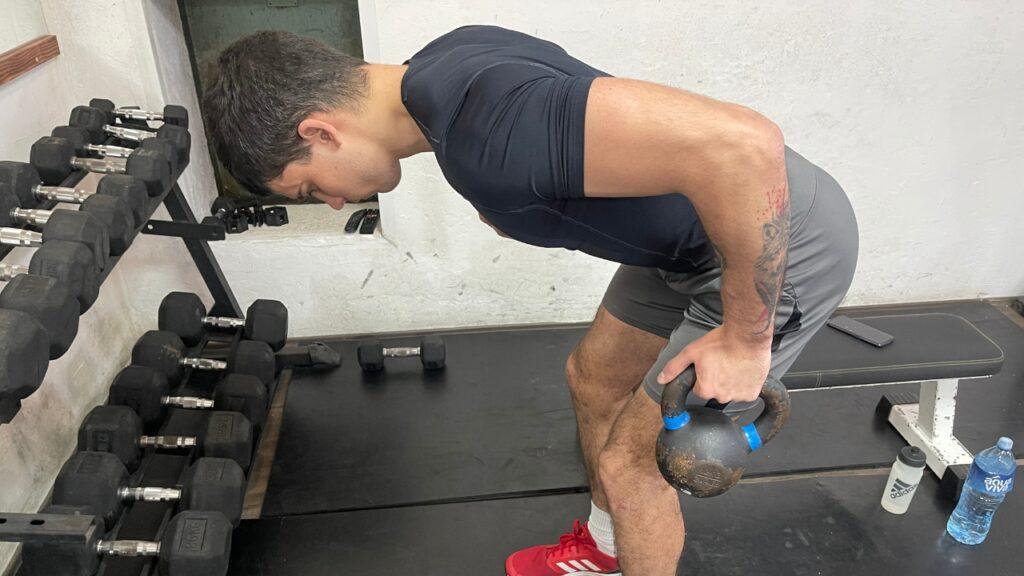
Steps:
- Stand with your feet shoulder-width apart, holding a kettlebell in one hand.
- Bend slightly at the hips and knees, keeping your back straight.
- Pull the kettlebell towards your hip, squeezing your lats at the top.
Pro Tip: Kettlebells have a different center of gravity compared to dumbbells. This can challenge your stability. I recommend that clients start with a lighter weight to get used to the motion. It’s a great way to engage the core and improve balance.
Single Arm Lat Row Resistance Band Alternative
Resistance bands are incredibly versatile and portable, making them a perfect option for those who travel or prefer home workouts.
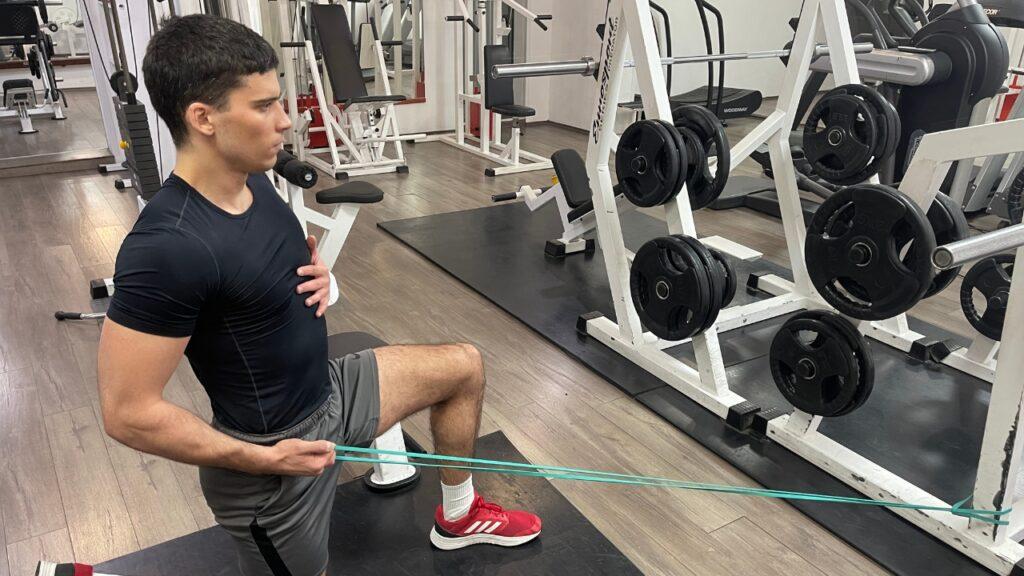
Steps:
- Secure a resistance band around a sturdy object at waist height.
- Stand perpendicular to the band and assume the half-kneeling position.
- Grab the band with your hand on the side where your knee is on the ground.
- Step out to create desirable tension.
- Perform the row as you would with a cable machine.
Pro Tip: Resistance bands offer a different type of resistance curve. I advise clients to focus on the end of the motion where the resistance is greatest. This maximizes lat engagement. Also, experimenting with different band thicknesses can help in progressively increasing the challenge.
Dumbbell Row vs Cable Row: Which Builds Larger Lats?
According to the study from the PubMed website titled “Comparison of different rowing exercises: trunk muscle activation and lumbar spine motion, load, and stiffness,” the standing bent-over row elicited large muscle activation symmetrically from the upper to lower back [1].
It induced larger spine loads but also, not surprisingly, the highest spine stiffness.
However, the study also found that if torsional endurance or strength is the training goal, the 1-armed cable row might be considered.
When it comes to building larger lats, both dumbbell rows and cable rows are highly effective, but they offer different benefits and challenges. Understanding these differences can help you choose the right exercise for your goals.
Dumbbell Row
Dumbbell rows allow for a greater range of motion and require more stability, engaging more stabilizing muscles in the process.
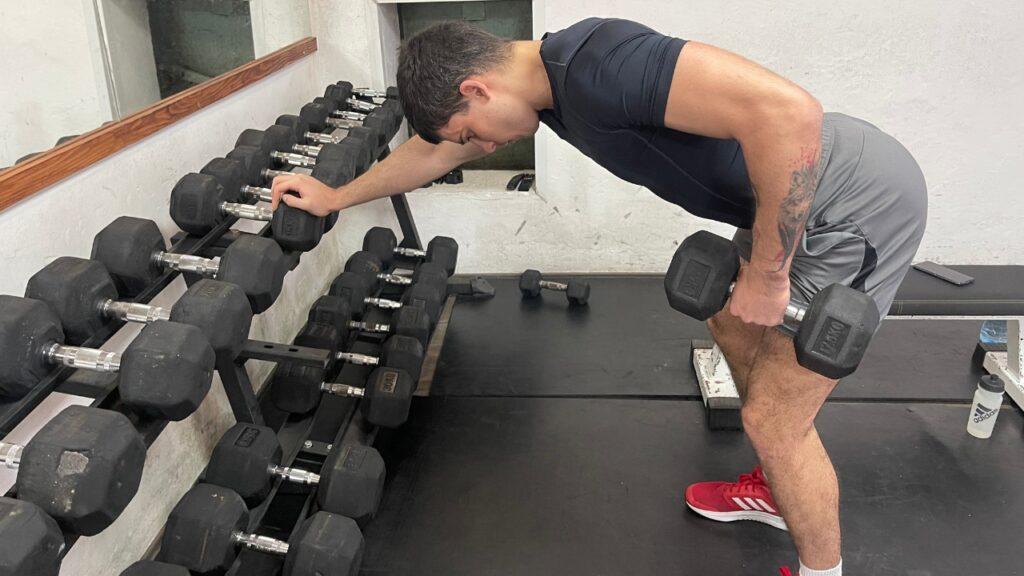
The freedom of movement with dumbbells can lead to a deeper stretch and contraction in the lats, which is crucial for muscle growth. Dumbbell rows can be performed anywhere with a set of dumbbells, making them a convenient option.
Cable Row
On the other hand, cable rows provide constant tension throughout the movement, which can lead to increased muscle activation.

The steady resistance of a cable machine helps maintain muscle engagement, especially at the peak of the contraction. The cable machine offers better control and can be more suitable for those focusing on form and controlled movements.
My Takeaway
In my personal training experience, I’ve found that clients often benefit from incorporating both types of rows into their workout routines. Dumbbell rows are excellent for building raw strength and muscle mass, while cable rows are ideal for refining muscle definition and enhancing mind-muscle connection.
Combining Both for Optimal Results
For those looking to maximize lat development, I recommend alternating between dumbbell and cable rows. This approach ensures a comprehensive lat workout, targeting the muscles from different angles and with varying types of resistance.
Single Arm Lat Row Variations
Introducing variations to the single-arm lat row can significantly enhance your back training regime. Here are two popular variations, each broken down into detailed steps to ensure you perform them effectively.
Seated Single Arm Lat Row
This variation allows for focused lat engagement due to the stable, seated position.
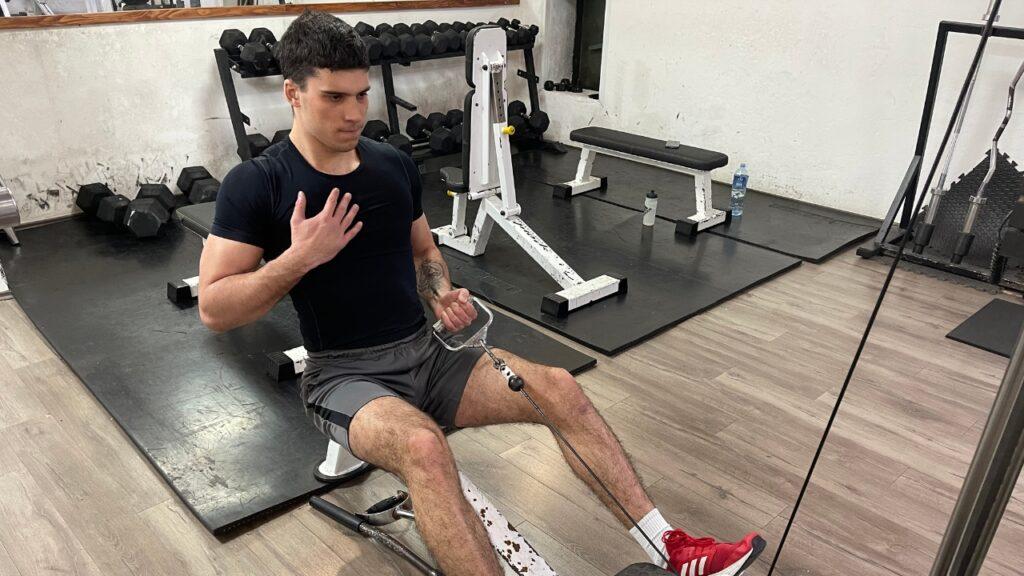
Steps:
- Choose a suitable weight on the cable machine and attach a single handle at the low setting.
- Sit on the bench, facing the machine.
- Plant your feet firmly on the machine, hip-width apart.
- Keep your back straight and core engaged.
- Grasp the handle with one hand, ensuring your arm is extended, and your palm faces inward.
- Engage your lat muscle and pull the handle towards your hip.
- Keep your elbow close to your body and ensure that your back drives the movement.
- Once the handle is near your hip, squeeze your lat muscle for a moment, maximizing the contraction.
- Slowly return the handle to the starting position, maintaining tension in the lat muscle.
Pro Tip: To maximize lat engagement, focus on driving your elbow straight back rather than outwards. This subtle tweak ensures deeper muscle activation, a technique I’ve found effective in enhancing muscle growth in clients.
Standing Single Arm Lat Row
Standing while performing the row engages more core muscles, adding a functional strength component.
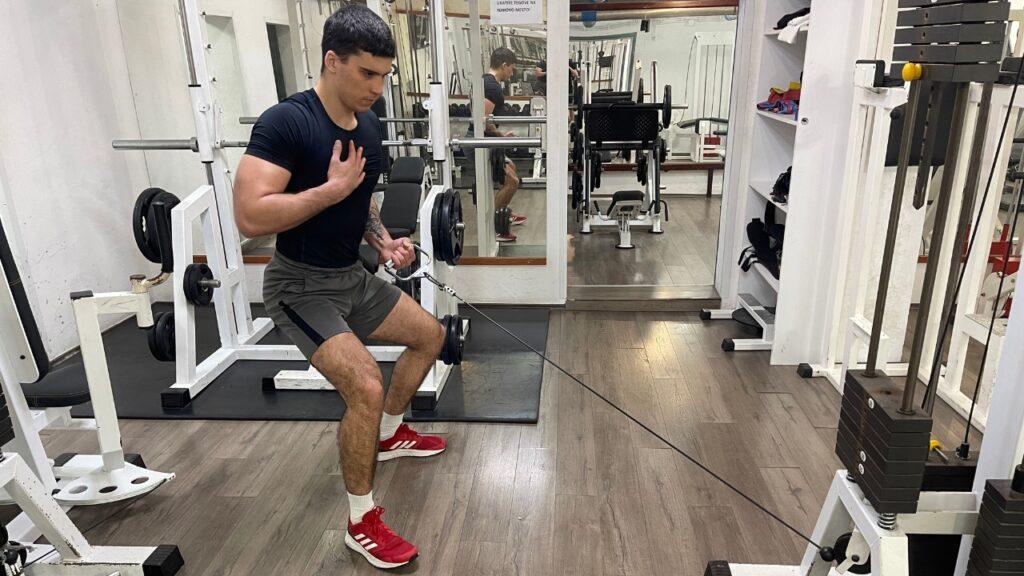
Steps:
- Adjust the cable machine to a low setting with a single handle and select an appropriate weight.
- Stand beside the cable machine; feet shoulder-width apart.
- Slightly bend your knees and lean forward from the hips, keeping your back straight.
- Grasp the handle with the hand closest to the machine.
- Keep your palm facing inward and your arm extended.
- Engage your core and lat muscles as you pull the handle towards your hip, focusing on keeping the elbow close to your body.
- When the handle reaches your hip, squeeze your lat muscle for optimal contraction.
- Return the handle to the starting position in a controlled manner, ensuring constant tension on the lat muscle throughout.
Pro Tip: Incorporate a slight twist towards the pulling arm at the peak of the movement. This rotational movement, when done correctly, engages not just the lats but also the obliques, offering a more comprehensive upper body workout.
FAQs
Do Single Arm Rows Work Your Lats?
Yes, single-arm rows work your lats, engaging the latissimus dorsi muscle effectively along with other muscles in the back during the exercise.
Are Cable Rows Enough?
Cable rows are enough for comprehensive back development, targeting multiple muscles, including the lats, though incorporating diverse exercises can enhance overall muscle growth.
Do Rows Build Big Lats?
Yes, rows build big lats by targeting the latissimus dorsi, a key muscle in the back that is essential for size and strength development. More precisely, rows will build thick lats, whereas lat pulldowns and pull-ups are better for lat width.
How Many Single Arm Rows Should I Do?
How many single-arm rows you should do depends on your fitness goals and experience, with 8-12 reps for 3-4 sets commonly recommended for muscle growth.
Wrapping Up
This guide has covered essential techniques for performing the single-arm lat row, a key exercise for lat development. Remember, proper form and varied equipment use—be it cable machines, dumbbells, or resistance bands—are crucial for effective workouts.
Mixing dumbbell and cable rows ensures a well-rounded approach to building stronger, more defined lats. Keep your training diverse, focus on technique, and stay consistent to achieve the best results in your fitness journey.
If you would prefer to do these rows at home, I suggest you take a look at the following articles to find appropriate equipment that won’t break the bank:
- Best Dumbbells for Home Gym
- Best Kettlebells for Home Gym
- Best Resistance Bands for Men
- Best Resistance Bands for Women
Start Building Your Dream Body Today
Ready to elevate your fitness game without falling into the trap of dull, repetitive routines that just don’t deliver? Imagine sculpting your ideal physique and boosting your health, all while still enjoying life’s pleasures, like those irresistible weekend getaways and your aunt’s legendary cheesecake. With our online fitness and nutrition coaching service, you don’t have to compromise. Dive into a personalized fitness journey that blends perfectly with your lifestyle, not against it. Book your completely free discovery consultation today, and take the first step towards a transformation that doesn’t require giving up the joys of life.

“I was skeptical about online fitness coaching, but Functional Body Savage completely changed my perspective. Vanja and Radomir’s personalized approach and attention to detail have helped me achieve goals I never thought possible. I’m stronger, more confident, and grateful for their guidance.”
Emily Thompson, San Francisco, CA
Learn More About Our Online Coaching ServiceReferences:
- Fenwick CM, Brown SH, McGill SM. Comparison of different rowing exercises: trunk muscle activation and lumbar spine motion, load, and stiffness. J Strength Cond Res. 2009;23(2):350-358. doi:10.1519/JSC.0b013e3181942019

